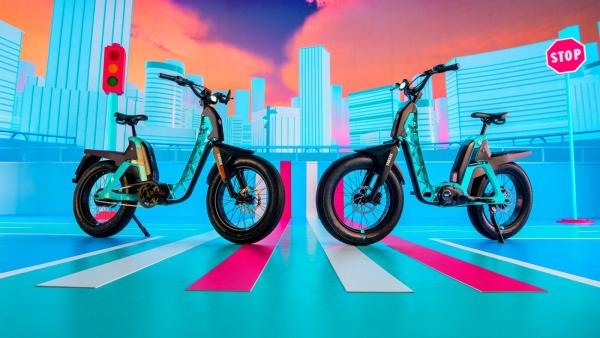
Two new Yamaha e-bike models have been launched, with the new Yamaha Booster and Yamaha Booster Easy.
Yamaha launched its e-bike range last year with gravel, mountain, and urban models, but specifically the new 2023 Booster differs from the 2022 Yamaha e-bikes.
Whereas the Booster Easy is still definitively an e-bike, the Booster is an S-pedelec. In effect, the Booster can be seen as an electric moped, and can reach 45kph (27mph), where the Easy can do 25kph (15.5mph).
In terms of the design, both carry similarities to the pedelec produced by Fantic, the Issimo, thanks to their diecast frame and fat, four-inch tyres (20-inch diameter). This is interesting, since Fantic and Yamaha have a collaboration on dirt bikes, but, while there are visual similarities between the Booster range and the Issimo range, the technical elements are not identical.
For example, the Booster models both use Yamaha’s PW-S2 drive unit, providing 75Nm of torque, whereas the Issimo’s motor produces 95Nm. Yamaha does not provide specifics on the suspension, but the front fork of the Booster would appear to bear similarities with the Issimo, while the brakes seem to be different - 180mm single discs front and rear on the Booster, 160mm front and rear on the Issimo.. In terms of the battery, both bikes use 630Wh 36V units; Fantic notes that it makes its own battery, as does Yamaha.
In terms of the comparisons against one another, the Booster and Booster Easy are fairly identical. The performance differences that come with the e-bike compared to the pedelec aside, the main difference is maximum range. For the Booster Easy, 120km is possible on a single charge, whereas the Booster can do 110km. This is variable depending on riding modes, though, of which five are available: +ECO, ECO, STD, HIGH and AUTO, with +ECO providing the longest range, and HIGH providing the highest performance. The different modes effectively alter the amount of assistance provided by the electric motor, but whichever mode you choose, on the pedelec Booster, the assistance starts to be backed down at 40kph, and is eliminated at 45kph.
The same modes are available on the Booster Easy, but of course the speed is limited to 15.5mph whichever mode you choose. There is also the Zero mode on the Easy, which eliminates the electric assist on downhills.
To keep track of what mode you’re in, the battery level, the speed, and other information, Yamaha has equipped both versions of the Booster with a 2.8-inch TFT display.
The Yamaha Booster Easy is already open for orders, with deliveries having begun in April 2023, while the Booster will begin delivery in June 2023.

